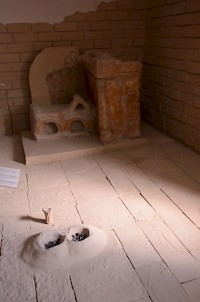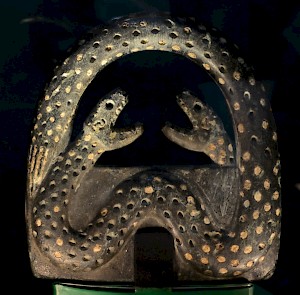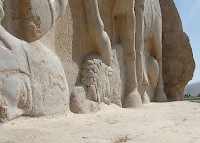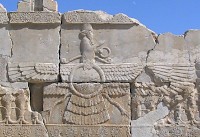Ahuramazda
Ahuramazda: the "wise lord", the supreme god of the ancient Iranians, whose cult was propagated by the legendary prophet Zarathustra, the founder of Zoroastrianism.
Zarathustra's teachings: the Gâthâs

The Avesta is the holy book of the adherents of Zarathustra, the Zoroastrians or - as they call themselves today - Parsis. The Avesta was codified c.600 CE, but this library of sacred texts contains older material, such as the Gâthâs. These hymns were perhaps written in the fourteenth or thirteenth century BCE, almost two millennia before the codification of the Avesta, and most scholars think that they were composed by the prophet Zarathustra himself.
In a vision (more...), Zarathustra was ordered by a spirit named Good Thought to start preaching against the bloody sacrifices of the traditional Iranian cults and to give aid to the poor. Gradually, the prophet began to understand that Good Thought had been sent by the supreme god Ahuramazda, a name that can be translated as Wise Lord. Zarathustra sometimes addresses his god as Ahura, lord, and as Mazda, wisdom.
From the Gâthâs, we learn that Zarathustra started to preach that Ahuramazda had created "the world, mankind and all good things in it" through his holy spirit, Spenta Mainyu. The rest of the universe was created by six other spirits, the Amesha Spentas ("holy immortals"). However, the order of this sevenfold creation was threatened by The Lie; good spirits and evil demons (daeva) were fighting and mankind had to support the good spirits in order to speed up the inevitable victory of Ahuramazda. The believer could side with Ahuramazda by avoiding lies, supporting the poor, several kinds of sacrifices, the cult of fire, et cetera.

Zarathustra also warned the people that there would be a Last Judgment. At the end of times, angels were to lead all men and women across a narrow bridge, where they would be judged by Spenta Manyu (which is described as a beautiful maiden); the friends of The Lie would fall into a large chasm of fire called Worst Existence, but the followers of Zarathustra were to reach Paradise, which goes under the name of House of Best Purpose.
It is impossible to establish how much of this is original. Zarathustra says in the Gâthâs that the innovative aspect was the demand for social reform, which brought the prophet into conflict with representants of the established cult, the priests of the god Mithra and the goddess Anahita. What strikes us is the radical dualism; Zarathustra demands that the pious choose for the good and against evil, and promises that they will be rewarded at the Last Judgment (text...).
Angra Mainyu, demons, and gods

The Gâthâs are only a small part of the Avesta, and it is possible to distinguish (on linguistic grounds) between old and young texts. The most important innovation by Zarathustra's disciples is the personalization of evil. According to Zarathustra, the enemy of the divine order had been The Lie, an abstract concept. There are several texts, written in the same language as the Gâthâs, which give evil its name: Angra Mainyu, "the hostile spirit". He is described as the leader of the demons.
It may be doubted whether Angra Mainyu has ever figured in Zarathustra's own thoughts. The fact that he does not mention this demon in the Gâthâs is significant; there are seventeen Gâthâs and they are of a considerable length, so it may be argued that Zarathustra had sufficient opportunity to mention Ahuramazda's opponent. Instead, he speaks consistently of The Lie.
On the other hand, the name Angra Mainyu is very old. It is, therefore, either a very early innovation, or it was a very common name which Zarathustra sought to replace by the more abstract concept of The Lie, which implied a greater personal responsibility. However this may be, it seems certain that the name of the hostile spirit was not very important to Zarathustra.
Another important question is whether Zarathustra was a monotheist. In the Gâthâs, he gives special attention to Ahuramazda and almost ignores all the other gods. They figure in other Avestan hymns, the Yashts, which are dedicated to lower deities. The Zoroastrian tradition is univocal that the Yashts were composed by Zarathustra, which would make him a polytheist. European scholars, however, have argued that the Yashts were not written by the prophet himself, because they are written in the language that is also known from the cuneiform texts of the Achaemenid empire written between 521 and 331 BCE. However this may be, it is certain that under the Achaemenid empire, Zoroastrianism was polytheistic.
The Achaemenids
Zarathustra is not mentioned in any of the cuneiform texts of the Achaemenid empire (although there is one seal mentioning his family name Spitama), and we may ask whether the Achaemenid kings were Zoroastrians. A first, tentative answer is "yes", because many of their texts mention Ahuramazda. Two examples from the famous Behistun inscription of king Darius I the Great:
(9) King Darius says: Ahuramazda has granted unto me this empire. Ahuramazda brought me help, until I gained this empire; by the grace of Ahuramazda do I hold this empire.
(63) King Darius says: [...] By the grace of Ahuramazda have I always acted. Ahuramazda brought me help, and the other gods, all that there are. [...] (64) On this account Ahuramazda brought me help, and all the other gods, all that there are, because I was not wicked, nor was I a liar, nor was I a tyrant, neither I nor any of my family. I have ruled according to righteousness. Neither to the weak nor to the powerful did I do wrong.
In other words: Darius protects the weak, is not a friend of The Lie and venerates Ahuramazda. This is interesting, but it does not prove very much, because we do not know how much of Zarathustra's teaching was original. Zoroastrians were probably not the only ones who believed in Ahuramazda (he is also mentioned in an Assyrian enumeration of native and foreign deities from the reign of king Aššurbanipal). On the other hand, Darius' dislike of "the lie" (and the use of this expression) is not a common theme in ancient political or religious texts.
Some scholars have argued that the following inscription from Susa by Artaxerxes II Mnemon (404-358) proves that the Achaemenid kings were not Zoroastrians:
Artaxerxes the Great King, [...] says: [...] By the favor of Ahuramazda, Anahita, and Mithra, this palace I built. May Ahuramazda, Anahita, and Mithra protect me from all evil, and that which I have built may they not shatter nor harm.note
It is indeed remarkable that Artaxerxes II invokes the goddess Anahita and the god Mithra, but as we have already seen above, Zarathustra was not a monotheist; he wrote Yashts for these two gods.
On the other hand, there is one specific point that suggests that the Achaemenid kings were indeed Zoroastrians. It is the way they use the name Ahuramazda. Originally, this was the god of wisdom, as is suggested by his name the Wise Lord. In the Gâthâs, he reveals that he is also the creator of "the world, mankind and all good things in it". The Achaemenid kings mention their supreme god frequently as a creator, which strongly suggests that they were at least influenced by Zoroastrian ideas:
A great god is Ahuramazda, who created this earth, who created yonder sky, who created man, who created happiness for man, who made Xerxes king, one king of many, one lord of many.note
This texts continues as follows:
There was a place where previously daivâ were worshipped. Afterwards, by the favor of Ahuramazda I destroyed that sanctuary of daivâ, and I made proclamation: "The daivâ shall not be worshipped!" Where previously the daivâ were worshipped, there I worshipped Ahuramazda at the proper time and in the proper manner.note
The word daivâ, which clearly means "demons", is a scribal error; presumably, the Avestan word daevâ is meant, which also means "demons". Again, this does not prove that Xerxes was a Zoroastrian, but it certainly does not contradict it.
A final argument is a quote by the fourth-century Greek philosopher known as pseudo-Plato, who describes the teacher of young Persian noblemen:
He teaches the science of the Magians, owing to Zarathustra, son of Ahuramazda. It is in fact the worship of the gods.note
Since it is certain that the Magians were involved in the state religion of the Achaemenid empire, we may argue that Zoroastrianism was Persia's official religion. On the other hand, we should not rely too heavily on an author who states that Zarathustra was the son of Ahuramazda.

Summing up the evidence, we see that the arguments against the Achaemenids being Zoroastrians are not completely convincing; on the other hand, the use of "Ahuramazda" as the name of a creator god, Darius' vehement dislike of The Lie, his suggestion that he protected the weak and Xerxes' use of the word daiva all suggest that these kings were influenced by Avestan doctrine. However, as proof this is not conclusive. Some have argued that the winged royal figure that can found on many Achaemenid buildings, clearly inspired on the Assyrian supreme god Aššur, is not Ahuramazda himself, but a symbolic representation called Faravahar, which reminds the believer that his soul must progress towards God. This is however too sceptical.note
Zurvanism
In one of the Gâthâs, Zarathustra seems to speak of Spenta Mainyu and Ahuramazda's adversary, who was later known as Angra Mainyu, as "twins":
Truly, there are two primal Spirits, twins renowned to be in conflict. In thought and word, in act they are two: the better and the bad.note
In the fifth century BCE or a some decades earlier, this line was reinterpreted: the twins were Angra Mainyu and Ahuramazda. This had important theological consequences. Evil was now not only a personified power - as we have seen above, that was nothing new - but it was an eternal cosmological power. It was not created. Ahuramazda had been the creator of everything; now he was just the creator of the good things.
This new doctrine is called Zurvanism, because Angra Mainyu and Ahuramazda were seen as the sons of Zurvan, the god of time. It was popular for some time; the Persian kings of the Sasanian dynasty (224-642 CE) adhered to Zurvanism. In the first years of this dynasty, the prophet Mani (216-276) combined Zurvanism and Christianity; his ideas became known as Manicheism, survived well into the fourteenth century, and may have influenced the European Cathars. At that moment, however, Zurvanism was dead. As a response to the rise of Islam, the Zoroastrians had returned to their ancient beliefs. Today, Zurvanism, which states that there are two gods, is regarded as a kind of heresy.
Ironically, Zurvanism was the Zoroastrian doctrine that became first and best known in Europe. It was picked up by the Greek historian Theopompus of Chios (born 378 BCE); his lost work is quoted by his compatriot Plutarch of Chaeronea:
Theopompus says that, according to the Magians, for three thousand years alternately the one god will dominate the other god and be dominated, and that for another three thousand years they will fight and make war, until one smashes up the domain of the other. note
These lines gave westerners the impression that Zoroastrianism was a kind of monotheism with a god and a satan; but this reconstruction of Zoroastrianism is, as we have already seen above, only possible by accepting that the Yashts and all other texts of the younger Avesta are based on an error.
Literature
- Mary Boyce, Textual sources for the study of Zoroastrianism (1984 Manchester)
- Mary Boyce, "The Religion of Cyrus the Great" in: A. Kuhrt and H. Sancisi-Weerdenburg (ed.): Achaemenid History III (1988 Leiden)
- Andrew R. Burn, Persia and the Greeks. The Defence of the West, c.546-478 B.C. (1962 London) pages 63-80
- Peter Clark, Zoroastrianism. An Introduction to an Ancient Faith (1998 Brighton)
- Sven S. Hartman, "Datierung der jungavestischen Apokalyptik" in: David Hellholm (ed.): Apocalypticism in the Mediterranean world and the Near East (1983 Tübingen)
- A. de Jong, Traditions of the Magi (1997 Leiden)
- P. Lecoq, "Un problème de religion achéménide: Ahura Mazda ou Xvarnah?" in: Orientalia J. Duchesne-Guillemin emerito oblata, 1984 Leiden, pages 301-326
- M. Schwartz, "The Religion of Achaemenian Iran" in: Ilya Gershevitch (ed.): The Cambridge History of Iran, vol. II: The Median and Achaemenian Periods (1985 Cambridge) pages 664-667